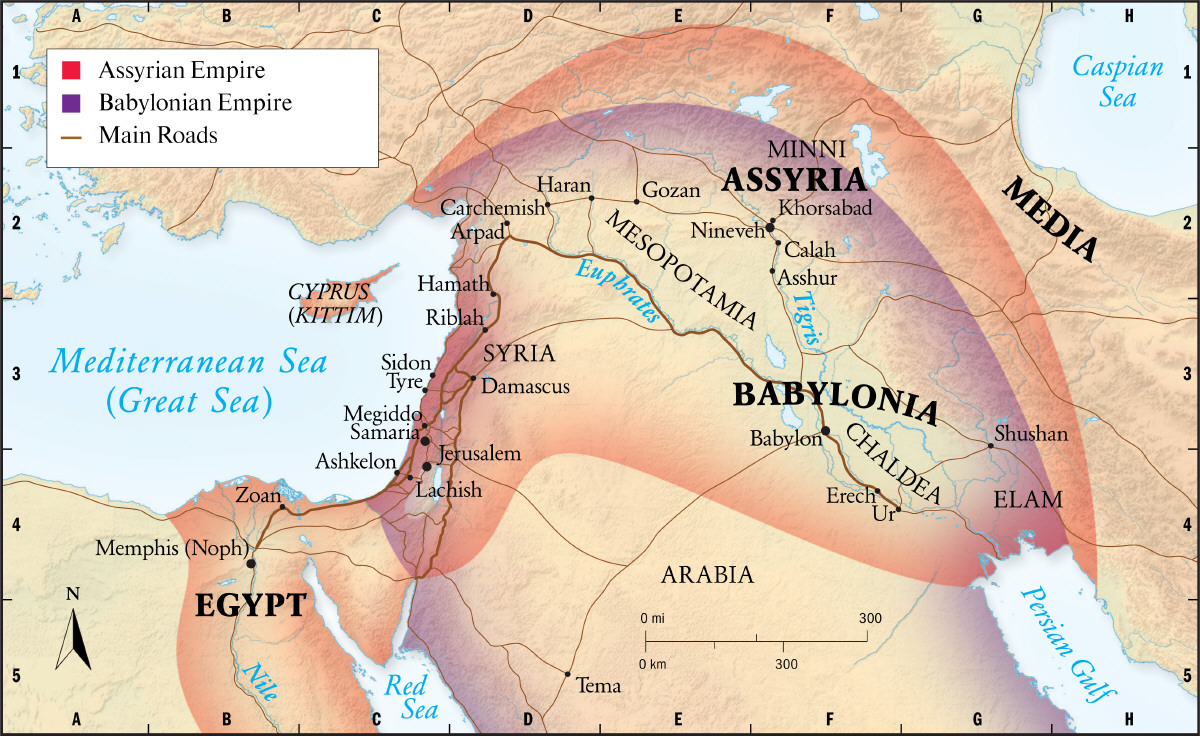The content displayed below is for educational and archival purposes only.
Unless stated otherwise, content is © Watch Tower Bible and Tract Society of Pennsylvania
You may be able to find the original on wol.jw.org
Empires Attack the Promised Land

SAMARIA, capital of the northern kingdom of Israel, was taken by the Assyrians in 740 B.C.E. The Israelites thus fell into the hands of a cruel empire. Assyria was located at the northern end of the Mesopotamian plains, near the Tigris, one of the mighty rivers of the Fertile Crescent. Nimrod had founded Assyria’s main cities, Nineveh and Calah. (Ge 10:8-12) In the days of Shalmaneser III, Assyria expanded westward, into the well-watered and productive regions of Syria and northern Israel.
Under the King Tiglath-pileser III (Pul), named in the Bible, Assyria began to oppress Israel. His military campaign also affected Judah to the south. (2Ki 15:19; 16:5-18) In time, the flooding “waters” of Assyria spread into Judah, eventually reaching its capital, Jerusalem.—Isa 8:5-8.
Assyrian King Sennacherib invaded Judah in 732 B.C.E. (2Ki 18:13, 14) He sacked 46 Judean cities, including Lachish, strategically situated in the Shephelah. As the map shows, this put his armies behind Jerusalem, thus encircling Judah’s capital. In his annals, Sennacherib boasted that he kept Hezekiah “like a bird in a cage,” but Assyrian records avoid mentioning the destruction of Sennacherib’s soldiers by God’s angel.—2Ki 18:17-36; 19:35-37.
The days of the Assyrian Empire were numbered. The Medes, centered on the rugged plateau of what is now Iran, began troubling what was left of the Assyrian army. This diverted Assyria’s attention from her western provinces, which also began to rebel. Meanwhile, the Babylonians were growing stronger, even capturing the city of Asshur. In 632 B.C.E., Nineveh—a “city of bloodshed”—fell to an alliance of Babylonians, Medes, and Scythians, a warlike people from north of the Black Sea. This fulfilled the prophecies of Nahum and Zephaniah.—Na 3:1; Zep 2:13.
Assyria’s last gasp came at Haran. Attacked by a determined force of Babylonians, the Assyrians tried to hold out until help from Egypt could arrive. But on his way north, Pharaoh Necho was blocked at Megiddo by the resistance of Judean King Josiah. (2Ki 23:29) When Necho finally reached Haran, it was too late—the Assyrian Empire had fallen.
Babylonian Empire
What city is brought to mind by the term “hanging gardens”? Babylon, the capital of the world power of that name and prophetically depicted as a winged lion. (Da 7:4) The city was well-known for its wealth, trade, and development of religion and astrology. The empire was centered in the marshy plains of southern Mesopotamia, between the Tigris and Euphrates rivers. The city straddled the Euphrates, and its walls made it seem impregnable.
The Babylonians developed trade routes across the rocky desert of northern Arabia. At one point, King Nabonidus resided at Tema, leaving Belshazzar to rule in Babylon.
Babylon invaded Canaan three times. After Nebuchadnezzar routed the Egyptians at Carchemish in 625 B.C.E., the Babylonians pushed south to Hamath, where they again defeated the retreating Egyptians. The Babylonians then swept down the coast to the torrent valley of Egypt, destroying Ashkelon on the way. (2Ki 24:7; Jer 47:5-7) During this campaign, Judah became a vassal of Babylon.—2Ki 24:1.
King Jehoiakim of Judah rebelled in 618 B.C.E. Babylon then sent the armies of nearby nations against Judah, and Babylon’s own troops besieged and subjugated Jerusalem. Before long, by allying his kingdom with Egypt, King Zedekiah aroused the Babylonians to climactic fury against Judah. They invaded again and began to destroy the cities of Judah. (Jer 34:7) Finally, Nebuchadnezzar turned his army’s attention to Jerusalem, conquering it in 607 B.C.E.—2Ch 36:17-21; Jer 39:10.
[Box on page 23]
BIBLE BOOKS FROM THIS PERIOD:
Hosea
Isaiah
Micah
Proverbs (part)
Zephaniah
Nahum
Habakkuk
Lamentations
Obadiah
Ezekiel
1 and 2 Kings
Jeremiah
[Map on page 23]
(For fully formatted text, see publication)
Babylonian/Assyrian Empires
Assyrian Empire
B4 Memphis (Noph)
B4 Zoan
B5 EGYPT
C2 CYPRUS (KITTIM)
C3 Sidon
C3 Tyre
C3 Megiddo
C3 Samaria
C4 Jerusalem
C4 Ashkelon
C4 Lachish
D2 Haran
D2 Carchemish
D2 Arpad
D2 Hamath
D3 Riblah
D3 SYRIA
D3 Damascus
E2 Gozan
E2 MESOPOTAMIA
F2 MINNI
F2 ASSYRIA
F2 Khorsabad
F2 Nineveh
F2 Calah
F2 Asshur
F3 BABYLONIA
F3 Babylon
F4 CHALDEA
F4 Erech
F4 Ur
G3 Shushan
G4 ELAM
Babylonian Empire
C3 Sidon
C3 Tyre
C3 Megiddo
C3 Samaria
C4 Jerusalem
C4 Ashkelon
C4 Lachish
D2 Haran
D2 Carchemish
D2 Arpad
D2 Hamath
D3 Riblah
D3 SYRIA
D3 Damascus
D5 Tema
E2 Gozan
E2 MESOPOTAMIA
E4 ARABIA
F2 MINNI
F2 ASSYRIA
F2 Khorsabad
F2 Nineveh
F2 Calah
F2 Asshur
F3 BABYLONIA
F3 Babylon
F4 CHALDEA
F4 Erech
F4 Ur
G3 Shushan
G4 ELAM
[Other locations]
G2 MEDIA
Main Roads (See publication)
[Bodies of water]
B3 Mediterranean Sea (Great Sea)
C5 Red Sea
H1 Caspian Sea
H5 Persian Gulf
[Rivers]
B5 Nile
E2 Euphrates
F3 Tigris
[Picture on page 22]
Tell Lachish
[Picture on page 22]
Model of ancient Megiddo
[Picture on page 23]
Concept of Babylon’s hanging gardens